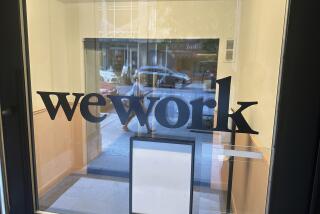TWA Cleared to Emerge From Bankruptcy
- Share via
Trans World Airlines--the once proud transatlantic carrier bloodied by deregulation, a takeover fight and fare wars--took a big step toward recovery Wednesday by getting judicial approval to emerge from bankruptcy.
A federal bankruptcy judge in Delaware approved a plan to reorganize TWA, under which the airline’s creditors will get 55% ownership while TWA’s workers--in exchange for more labor concessions--will own an unusually large 45% stake in their employer.
TWA’s emergence from bankruptcy leaves America West as the last major U.S. airline trying to reorganize under bankruptcy court protection, and it contributes to the modest rebound in the airline industry’s financial health.
The approval gives TWA, once owned by billionaire Howard Hughes, a new chance at survival. Indeed, the plan enables the 63-year-old carrier to counter skeptics who had believed TWA might die before emerging from bankruptcy protection--as other once-famous airlines, such as Pan American and Eastern, had done.
Instead, TWA is officially expected to emerge from Chapter 11 protection by early next month. The company had filed under Chapter 11 in January, 1992, in order to obtain a shield from creditors’ claims while company officials worked out the reorganization plan.
But TWA’s future is by no means secure.
TWA and its rivals continue to engage in relentless price-cutting, which helps them maintain market share but also keeps a lid on profits. The major airlines also face strong competition on certain routes from low-cost competitors such as Southwest Airlines and new entrants such as Reno Air.
The U.S. airline industry, which together lost more than $8 billion during the past three years because of the economic recession and fare wars, generally posted tepid profits in this year’s second quarter.
Analysts say TWA must move quickly to raise more cash for lean times ahead and to polish its reputation. Complaints to the federal government from TWA passengers have been high, although they began declining this year.
For now, though, TWA has accomplished its main priority: survival. It did so in large part because its employees were willing to swap part of their wages and benefits for partial ownership of the company.
Similar concessions by employees of Northwest Airlines helped that company avert a bankruptcy filing earlier this summer.
TWA’s next challenge will be to survive the typical drop in travel that occurs in the fall and winter often triggering more price cuts. “You can set your clock by the fare wars that will start in September,” said Thomas Nulty, president of Associated Travel Management, a travel agency based in Santa Ana.
But TWA reached several last-minute financial agreements to help it through that period, including pacts with the City of St. Louis and European aircraft maker Airbus Industrie that lifted TWA’s total cash cushion to $200 million.
“The employee-owners of TWA have a proud tradition and want to show their passengers what a world-class, full-service airline can do,” William R. Howard, TWA’s incoming chairman and chief executive, said in a statement.
After Hughes bought the airline 50 years ago, it was considered one of the country’s premier transatlantic airlines. But its many years of problems have left it with one of the oldest fleets of jets in the industry, and none of its once-lucrative routes to London.
Analysts have said TWA’s potential for a rebound was strengthened by the recent appointment of Howard, a former chief executive of Piedmont Airlines, a successful carrier that was later bought by USAir.
Howard was brought in to replace Carl C. Icahn, the New York financier who bought control of TWA in 1985 and then took the carrier private in 1988.
TWA currently is based in Mt. Kisco, N.Y., Icahn’s hometown, but the airline is expected to announce soon that it will relocate its headquarters to St. Louis. The carrier’s chief “hubs” are New York and St. Louis, from which TWA’s passengers can fly to Paris and other European cities and the Middle East.
TWA remained a premier airline until the industry was deregulated in 1978 and airlines were free to set their own prices.
Before then, TWA and Pan American had offered luxury often matched only by foreign airlines. TWA passengers were treated to sleeper seats, fine china, slippers for night trips and the novelty of in-flight movies.
But once deregulated, carriers such as TWA were saddled with high operating and labor costs while being forced to slash ticket prices to stay competitive. The result was big losses during much of the 1980s.
TWA limped along, occasionally showing glimmers of revival, but it was eventually buried under its high debt when the recession and Persian Gulf War combined to scare away passengers and inflate fuel costs.
TWA finally landed in bankruptcy court when the fare wars left its cash levels precariously low and its debt too high. Icahn quit the airline in January after agreeing to lend it $200 million and paying millions into retirement funds. He was temporarily replaced by managers appointed by TWA’s creditors and employees.
The Associated Press contributed to this story.
More to Read
Inside the business of entertainment
The Wide Shot brings you news, analysis and insights on everything from streaming wars to production — and what it all means for the future.
You may occasionally receive promotional content from the Los Angeles Times.











